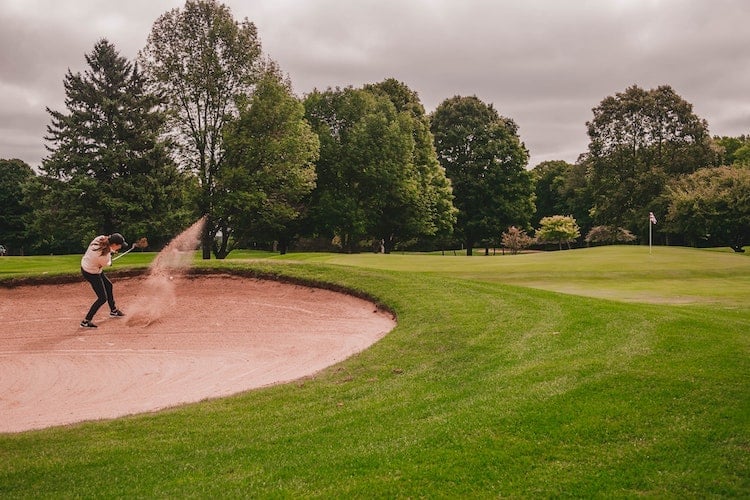
If it weren’t for my ability to scramble I would never have gotten near a single-figure handicap. I knew my long game was horrendous, so I relied on creative shots to rescue me and give me a fighting chance of saving par.
In this guide, I explain what scrambling golf is, contrary to the numerous incorrect descriptions on the internet.
What is Scrambling in Golf?
Simply put, scrambling explains your ability to save par after missing a green in regulation (GIR). Golf Magazine explains that many are under the impression that scrambling only involves your wedges, but it refers to your whole game.
Let me give you an example of my finest scramble ever. I duck hooked my drive into the woods on a par 4 and punched out for two to 170-yards. My third shot kicked off the green and into the bunker and held the best shot of my life to save par. At no point on that hole was I in a position to make par, but I did.
In addition, if you miss the green on a par 3, chip it close and get up and down. That is a scramble.
Let me also provide samples of unsuccessful scrambles. If you hit your tee shot into the drink on a par 4, then play three from the drop zone, and end up making bogey, that is a failed scramble.
In layman’s terms, scrambling refers to the percentage a player misses the green in regulation and still manages to make par or better.
Example of How to Calculate a Scramble
Let’s look at the 2022 PGA Tour scrambling averages to learn how to calculate a scramble percentage. Daniel Berger leads the charge this season with 78%. It is calculated by dividing the total number of missed greens in regulation by the times a player scored par or better.
In Berger’s case, he has missed fifty GIRs this year but made par or better on thirty-nine occasions. As a result, he has a scrambling average of 78%.
The next time you play, calculate how many GIRs you miss and the number of pars or birdies you make from that position. Let me offer a more realistic example for the average golfer. If you miss 14 greens during your round and make par three times, your scrambling average is 21.4%.
What Is Scrambling Percentage In Golf?
The scrambling percentage in a game of golf highlights how many times the player has scored par or better after missing a green in regulation. For example, if you miss fifty GIRs, and make par or better on twenty-five of those holes, your scrambling percentage would be 50%.
Pros and Cons of This Measurement
Pros
Measures Resilience
A scrambling average more than anything measures a golfer’s resilience to recover after missing a green in regulation. The more pars you record when missing the GIR, the better it is for your confidence and overall mental strength on an 18-hole course.
Short Game Performance
Because this stat focuses on missed GIRs, a high record tends to demonstrate solid iron and wedge play. The ability to recover from a missed green shows that you have your distance control and accuracy dialed.
With that in mind, it doesn’t provide insight into your performance on the greens when you hit a GIR. Therefore, it is not a complete representation of your short game.
Highlights Inaccuracy
Because this stat revolves around missed greens in regulation, it does highlight your long game and approach inaccuracies. If you find yourself scrambling on most holes on the course, your long game is letting you down.
It could be caused by an incorrect swing path or aim that sends your ball off your intended line. While the stats don’t specifically identify where it is going wrong, it highlights where you need to improve.
From my personal experience, my outside-in swing path with my irons and woods sprayed balls all over the course. That meant I needed to up my scrambling to reduce my scores.
Cons
Says Little About Your Score
Even if you possess a high scrambling average, it says nothing about your overall score. That is why it is not a great representation of the overall picture.
It Disregards The Position Of A Tee Shot
If you hook your ball into the woods, and you chip out and are left 220-yards to the flag, most mid to high handicappers will miss the green from that range. Therefore, your scrambling record will show that you missed a GIR and did not make a par or better, but your tee shot never gave you a chance of getting there.
Verdict: Should You Use This Measurement to Improve Your Game?
I believe scrambling is a vital component to consistency on the golf course. However, it is more about your creativity and escaping trouble than the stats. Learn to get creative to escape difficulty and master the art of a pitch, chip, and putt. If you can scramble, it will save you numerous shots on a bad day.
A scrambling average can tell you that your long game is inaccurate and causing you to miss greens. Plus, it also looks at how consistent you are at recovering and making par or better when you miss a green in regulation.
Overall, scrambling will not improve your golf game, but it will help you save shots when you struggle to attack the flag.

